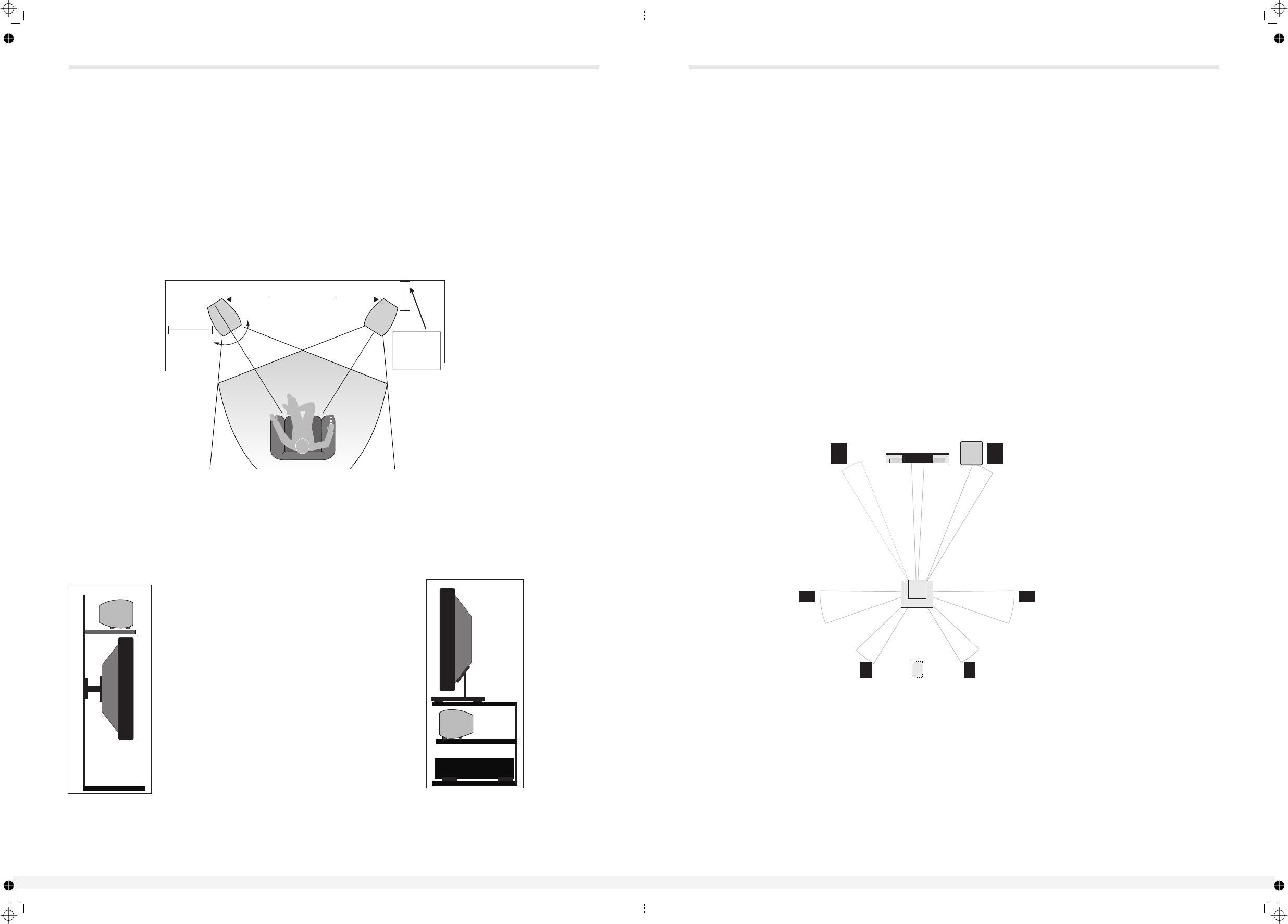
Positioning the Front Loudspeakers
The 10.3, 10.4,10.5, 10.6 and 10.7 models are designed to be floor standing. We suggest that they are positioned at least 200
mm from the rear walls and 700 mm from the side walls, facing slightly inwards.The 10.1, and 10.2 models should be stand
or wall mounted though they may be placed on a rigid shelf.The 10.0 model can be stand or wall mounted.The bass
extension will improve if the small speakers are operated closer to the rear wall.
If the loudspeakers are placed too close to the walls the bass will increase but may be boomy and indistinct. If the
loudspeakers are placed away from the walls, the inward angle may be increased by up to 40%, although this may
restrict the width of the optimum listening position.
A useful rule of thumb is that the listener should be as far from the loudspeakers as they are from each other. The
speakers should ideally be positioned so that the treble units are roughly at ear level to a seated listener. As personal
taste plays a large role, experiment with different configurations and play a wide range of programmes before
finalising the position of your speakers.
The Centre channel loudspeaker should be positioned centrally between the loudspeakers, close to the television
and mounted above or below the screen.
The loudspeaker should be located on a stable flat surface to avoid
any cabinet movement at high sound levels. If you mount the unit
above the television, move it forward so that the front grille sits
slightly in front of the screen.This will reduce sound reflections
from the screen and the top of the cabinet.
Centre channel speakers are supplied with a set of four self
adhesive mounting feet and two extra feet. Remove the protective
backing from four feet. Place the feet at the bottom of the cabinet.
Attach each foot 10 mm in from the sides of the cabinet and place
them so that the cabinet is supported in a horizontal position with
the curve of the cabinet clear of the shelf.The extra feet enable
you to tilt the cabinet up or down so that the speaker points
directly at the listening position.This facility is particularly useful if
the speaker is mounted under the screen.
Positioning the Centre Loudspeaker
2 - 4 metres
1
5
-
4
0
º
>0.7metre
10.0 - 10.2
>50 mm
10.3 - 10.7
>200 mm
A custom stand is available for the D10 CM which allows the
loudspeaker to be positioned under a wall mounted monitor and
has an adjustable vertical tilt for optimal dispersion.
6
Placement
Setting Loudspeaker Sizes and Levels
Front And Effects Channels:
Subwoofer:
If you are not using a subwoofer:
If you are using a subwoofer:
The front loudspeakers are placed on either side of the television screen, 2 to 3 metres
apart. The speakers should be angled slightly so they are aimed towards the listeners.
We recommend placing the rear effects speakers in a high position, behind the listener’s head. If the rear or side
walls are a long way from the listening seat, consider stand mounting the loudspeakers. If the centre loudspeaker is
very high or low, angle it towards the listener's ear level. The front faces of the centre and surround loudspeakers
should also be in line as far as possible.
As the ear is unable to detect the direction from which deep bass originates, you have freedom to
position the unit.Varying the distance from the wall alters the bass. Placing the subwoofer across a corner boosts
the bass but may impair clarity. The performance of HomeTheatre systems is enhanced by using two subwoofers.
Dolby Labs, DTS andTHX offer 6.1 and 7.1 formats. Although the precise configuration of these systems will depend
on the capabilities of your processor and you should be guided by those instructions, we would make some
observations.
For 6.1 and 7.1 formats the listening seat should not be too close to the rear wall.
Optimising the time delay so that information from all speakers arrives at the listening seat coherently is critical if
the benefits of these systems are to be fully realised.
Set the Front Speakers to‘Large’. Set the‘Subwoofer’option on the processor to
'Off' or‘No'.The Front channels will now receive all the system bass.
When set to‘Small’all the system bass will go into the subwoofer. If you choose
‘Large’the Front channel bass will be reproduced from the Front speakers. Follow the instructions on the previous
page for suitable size and crossover settings.
Once the loudspeaker settings have been finalised, put the AV amplifier into its“Test”mode and adjust the level of
each channel until all channels are reproduced at equal loudness. You may need to adjust the subwoofer output
level. Avoid setting too high a level or you will swamp the sound with bass which be tiring to listen to and may limit
the subwoofer’s ability to respond to large bass transients. Set a sensible level going into the subwoofer.The
subwoofer volume control should be between 12 o’clock and 3 o’clock
6.1 and 7.1 System Placement
Setting Up a Home Theatre System
Some of this chapter may appear to repeat the content of the Subwoofer pages - the context however is different.
Left Surround
Left Back
90º
110º
135º
150º
22º
30º
LFE
Centre
Right Back
Right Surround
Right Front
Left Front
(Single Back channel for 6.1
Dolby Labs Recommended Placement for Multichannel HomeTheatre Systems
15












